
- Description: Mythological king who ruled Britain during the medieval period
- Nationality: English
- Date of Birth: Late 5th century
- Place of Birth: Tintagel
- Death: Early 6th century
- Role: British King
- Parents: King Uther Pendragon and Igraine the Duchess of Cornwall
- Nickname: The One, True King of the Britons
- Books: Le Morte D’Arthur (1485), Idylls of the King (1800s), Mists of Avalon (1982)
- Movies: Excalibur (1981), King Arthur (2004), Knights of the Roundtable: King Arthur (2016)
- Legend: The Arthurian Legend Is an Important Part of British History
- Etymology: There Are Many Different Theories Regarding the Origin of King Arthur’s Name
- History: King Arthur’s Kingdom Was Called Camelot
- Marriage: King Arthur Married Queen Guinevere, Who Later Betrayed Him
- Children: Different Sources Provide Different Information on Whether King Arthur Had Children
- Death: King Arthur Was Presumably Killed in His Last Battle: the Battle of Camlann
- Legend: In One of the Most Famous Legends, King Arthur Pulled a Sword from a Stone
- Legend: King Arthur’s Magnificent Sword Was Called Excalibur
- Legend: The Holy Grail Is Another Important Part of The Legend of King Arthur
- Legend: The Knights Met at Arthur’s Round Table in Camelot
- King Arthur Was One of the Nine Worthies
- King Arthur Had a Special Relationship with Merlin the Enchanter
- Some Historical Facts Suggest that Arthur Was Not Really a King
- Despite His Fame, There Is Actually Very Little Evidence that King Arthur Really Existed
- Apart from Excalibur, King Arthur Also Had Other Famous Weapons
- Until His Betrayal, Lancelot Was King Arthur’s Best Knight
- The Lady of the Lake Played an Important Part in the Story of King Arthur
- Cadbury Castle Is Believed to Have Been a Part of Camelot
- A Number of Other Places Could Actually Have Been a Part of the Camelot Kingdom
- It Is Still Not Completely Clear Where Exactly King Arthur Could Be Buried
King Arthur Facts Infographics
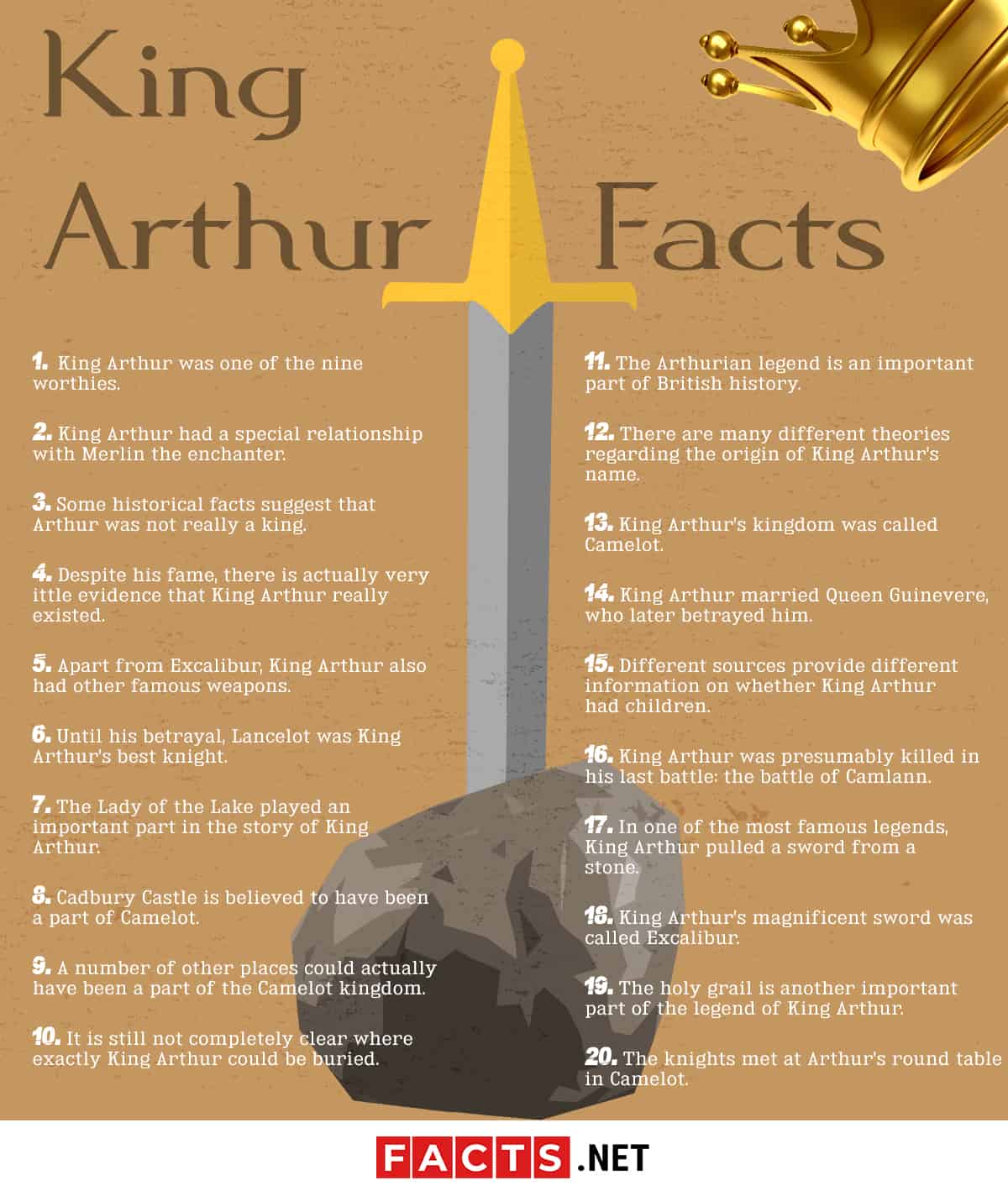
The Arthurian Legend Is an Important Part of British History
King Arthur facts reveal that there are numerous variations of the Arthurian legend, but the basic story is very similar in most of them. Arthur was the illegitimate son of the King of Britain who succeeded his throne by showing his worth in an unusual feat of strength, and later successfully fought many powerful enemies to secure his kingdom’s place in the world.
Stories about King Arthur had been popular in Wales even before the 11th century, but the legend spread through Europe with Geoffrey of Monmouth’s Historia regum Britanniae, which was written circa 1138 and celebrated a glorious king who defeated a powerful Roman army in France, but was later betrayed in his homeland by a member of his own family and was mortally wounded combating his forces. Writings that came after Geoffrey introduced additional details, especially about his loyal knight companions and the Holy Grail.
There Are Many Different Theories Regarding the Origin of King Arthur’s Name
King Arthur facts reveal that there are many theories about the origins of the great king’s name. Some scholars believe that his name simply comes from the Roman family name Artorius, which most likely derives from Etruscan, while others believe that the root for the name Arthur comes from the Celtic Art-rig, meaning the Bear King, or from the star Arcturus which is located near the constellation Ursa Major (Great Bear). Or it could also come from the Old Irish name Artúr, which derives from an Old Welsh or Cumbric name.
King Arthur’s Kingdom Was Called Camelot
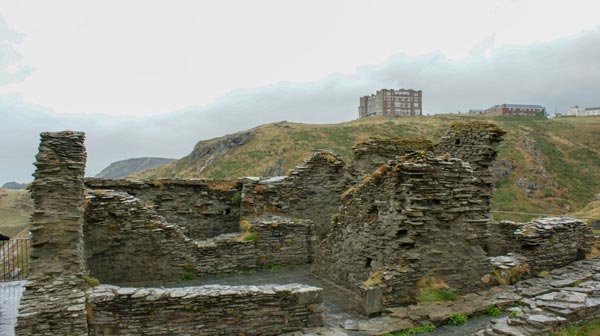
King Arthur’s mythical kingdom from where he ruled was called Camelot. Most modern historians agree that King Arthur’s kingdom was just a legendary utopia where peace and justice ruled, thus opposing the harsh reality of the Middle Ages, where violence, disease and barbarism were commonplace.
Camelot was first introduced into the Arthurian legend as a town in the late 12th century by a French poet, De Troyes, in his tale of Arthur’s knight Lancelot. Camelot become the mighty kingdom of modern Arthurian tales in the centuries that followed in the works of various other authors.
King Arthur Married Queen Guinevere, Who Later Betrayed Him
King Arthur facts reveal the presence of his great love – Queen Guinevere (also known as Gwenevere, Guenevere, Guenievre, Guenhumare, Ginevra, Gwenhwyfar or Jenefer). There are numerous variations of Guinevere’s story in the Arthurian legend, but she is mostly portrayed as an adulteress who had an affair with Arthur’s first knight Lancelot, and later became wife to Arthur’s traitorous nephew, Sir Mordred. She was either the daughter of a king herself, or a descendant of a noble Roman family, and was always portrayed as an exceptionally beautiful, but tragic romantic (anti) heroine.
Different Sources Provide Different Information on Whether King Arthur Had Children
King Arthur facts that deal with his children differ greatly from each other, with some claiming that he had children and some that he died (or disappeared) childless. Among those sources that describe his children, we can find both early and late Arthurian tales, and the first descendant of the great King Arthur to ever be mentioned is found in the 9th century Historia Brittonum:
‘ To ANACREON in Heav’n, where he sat in full Glee,
A few Sons of Harmony sent a Petition,
That He their Inspirer and Patron wou’d be;
When this Answer arriv’d from the JOLLY OLD GRECIAN
Voice, Fiddle, and Flute,
No longer be mute,
I’ll lend you my Name and inspire you to boot,
And, besides, I’ll instruct you like me, to intwine
The Myrtle of VENUS with BACCHUS’s Vine ‘
Other children of Arthur who are frequently mentioned in Arthurian legends are Gwydre, Llacheu and Loholt, and later writings, such as Tom Thumb, The Bridal of Triermain and modern-day film and television adaptations, also mention Arthur’s daughters – details of whom cannot be found in any of the earlier tales.
King Arthur Was Presumably Killed in His Last Battle: the Battle of Camlann
King Arthur facts show that the great king’s last battle was the Battle of Camlann, where Arthur died or was fatally wounded (depending on the source). In one of the most popular tales, his wife Guinevere and his first knight Lancelot had an affair, so Arthur besieged Lancelot’s castle for months, but couldn’t defeat his former friend. Eventually, an agreement was reached, according to which Arthur got his wife back and Lancelot was left alive, but exiled to France.
However, Arthur still couldn’t forgive his ex-friend Lancelot, so he followed him to France, leaving his nephew/son Mordred in charge of the kingdom. But Mordred wanted the kingdom for himself and took Guinevere as his wife, so Arthur was forced to return home to get his kingdom back. During a great battle, the Battle of Camlann, Mordred and Arthur mortally wounded each other, but Three Fairy Queens took Arthur’s body and sailed to the mysterious island of Avalon, presumably to cure his wounds. Some say that he still lies there, sleeping in a hollow hill, waiting to be awakened one day to defend Britain, when Britain really needs him…
In One of the Most Famous Legends, King Arthur Pulled a Sword from a Stone
In one of the most famous of the Arthurian tales that are revealed by King Arthur facts, Arthur pulled a sword from a stone. And why would he do that? By pulling the sword from the stone, Arthur proved his lineage, and proved that he was worthy of the throne of Britain.
This part of the Arthurian legend was added in the 12th century by a poet called Robert the Boron, and slightly altered previously predominant tales of Arthur. This version of the story presented an Arthur who was given up by his father, the King, and had to be raised as a nobleman’s son, far from the King’s palace. Arthur was not aware of his real father, so when the King died, England offered no real heir to take the throne; rival dukes and lords disputed and searched for the best man to become the king. Finding no solution, they asked Merlin to help them.
Merlin wanted to give Arthur a chance to grow up and become a man before taking the throne, so he erected a large stone with an anvil on top, and stuck in the anvil was a sword with an inscription: “Whoso pulleth out this sword from this stone, is right wise King born of all England.” Thousands of men tried to pull the sword out of the stone, but none succeeded and the sword became forgotten, with England falling into greater ruin. But the boy Arthur grew up under the careful tutelage of Merlin, and on his 15th birthday, he was taken to the stone. He pulled the sword out of it, thus becoming the rightful King of England.
King Arthur’s Magnificent Sword Was Called Excalibur
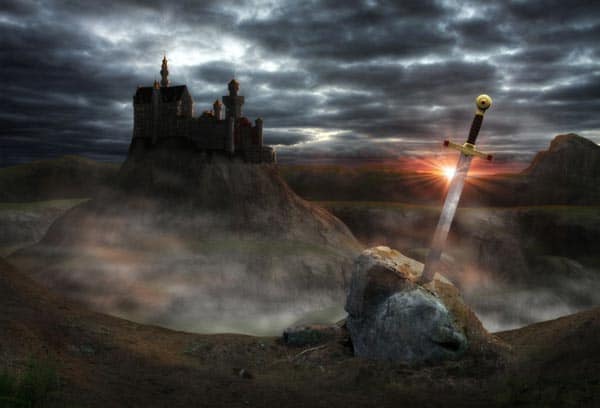
The most famous tale of King Arthur’s sword Excalibur is the “Sword in the Stone” legend, according to which Arthur had to pull the sword out of a mighty stone to prove his worth, but Excalibur was first mentioned in a tale that did not include the sword in the stone. Arthur gaining the sword was actually a consequence of his trusted advisor Merlin taking him to a magical lake where a mysterious hand appeared from the water holding the sword. The hand belonged to the Lady of the Lake, who offered Arthur an indestructible sword and a scabbard which would protect him.
Not many fans of the Arthurian legend know that Arthur’s sword was not named Excalibur in early tales, but Caladfwlch (a Welsh word meaning “hard lightning”). Geoffrey of Monmouth’s famous tale of Arthur had a sword called Calibrun, and from that name the sword’s modern name evolved: Excalibur.
The Holy Grail Is Another Important Part of The Legend of King Arthur
Most people know the Holy Grail as the chalice from which Jesus Christ drank during the Last Supper, or the chalice which caught his blood when he was crucified, so it was always believed to be a sacred artifact which possessed great powers of healing or even immortality itself. As such a valuable object, it often found a place in the Tales of King Arthur and his friends who went on various quests to search for the relic. Only one knight was worthy of the relic in these tales (usually Percival or Galahad) – the others were denied its powers due to their impurities.
The Knights Met at Arthur’s Round Table in Camelot
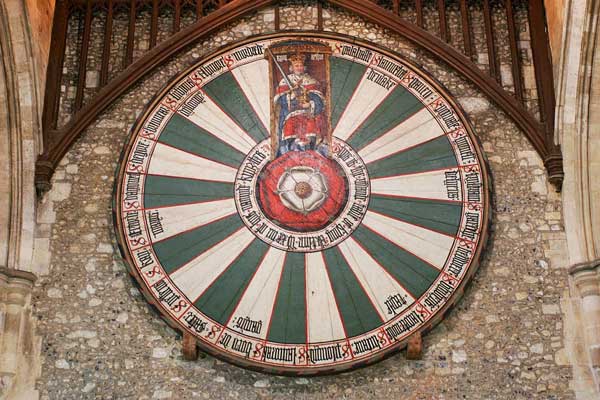
Arthur would never have been what he became without his fellow knights who helped him rule his kingdom. King Arthur facts reveal that the great man and his knights met at Arthur’s Round Table in Camelot to discuss important issues of the kingdom. The table’s round shape indicated that all sitting around it had equal status. It later became a metaphor for the highest chivalric order in King Arthur’s court – an order of the best British knights, who followed a strict code of honor which obliged them: to never do outrage nor murder, to always flee treason, to by no means be cruel but to give mercy unto him who asks for mercy, to always do ladies, gentlewomen and widows succor, to never force ladies, gentlewomen or widows, and to never take up battles in wrongful quarrels for love or worldly goods.
This part of the Arthurian legend was first introduced in the mid-12th century, in Wace’s story Roman de Brut, a rewrite of Arthur’s story from the more famous Geoffrey of Monmouth’s History of the Kings in Britain. Arthur chose the round shape of the table to prevent any quarrels over the seating order and to show his fellow knights that they were equal to him when they sat at the table. Some tales feature a different story: the table was constructed by Arthur’s father and given to Arthur for his wedding present.
King Arthur Was One of the Nine Worthies
The Nine Worthies are nine legendary historical personages who personify the ideals of chivalry as established during the Middle Ages and, according to King Arthur facts, Arthur is one of them, claiming his rightful place among extraordinary men such as Hector, Alexander the Great, Julius Caesar, Joshua, David, Judas Maccabeus, Charlemagne and Godfrey of Bouillon. The Nine Worthies together represent the perfect chivalrous warrior and the perfection of knighthood. They are often referred to as “Princes”, although each of them carried his own titles.
King Arthur Had a Special Relationship with Merlin the Enchanter

Merlin is one of the greatest magicians in literature and it is even possible that he originated from an old British deity. Merlin the Enchanter was Arthur’s teacher, mentor, advisor and friend, and played a big part in Arthur getting his mighty sword and the British throne.
Merlin was added to the Arthurian legend by Geoffrey of Monmouth, who combined the stories of a North Brythonic prophet and madman named Myddin Wyllt (also known as Merlinus Caledonensis), and stories of a Roman-British war general, Ambrosius Aurelianus. In later stories, Merlin was even represented as a half-mortal and a symbol of the Celtic Druidic faith and its associated magic. He is still an important figure nowadays, especially in many of the various traditions of Wales.
Some Historical Facts Suggest that Arthur Was Not Really a King
King Arthur facts might also reveal a surprising truth that King Arthur was not really a king at all. His early portrayals in stories do not refer to Arthur as “rex” (king), but rather as “dux” (leader or soldier). He is described as a British general and Christian warrior during times when Britain was regularly attacked by Anglo-Saxon tribes. His royal status is added in later stories and it is not completely clear how King Arthur evolved from the warrior Arthur.
Despite His Fame, There Is Actually Very Little Evidence that King Arthur Really Existed
Historians have never quite agreed on Arthur’s origins. Some claim that he was a genuine historical figure (citing the History of the Britons and Welsh Annals as their sources) and others believe that he is just a legend, created from various stories and heroes that came before. If he really existed, he was probably a general who defended Britain against the Anglo-Saxons in the late 5th and early 6th centuries. But there is no clear historical evidence supporting this claim and many historians wonder why such an important figure would appear only in writings a few centuries younger than himself, and not in other important documents of his time – documents such as the 6th century On the Ruin and Conquest of Britain (original title De Excidio et Conquestu Britanniae).
Apart from Excalibur, King Arthur Also Had Other Famous Weapons
Most people know that Arthur wielded the mighty sword Excalibur, but King Arthur facts reveal that he also owned several other weapons. Traditional Welsh stories mention a dagger called Carnwennan (meaning the “little white-hilt”) and a spear called Rhongomyniad (meaning the “spear slayer”). Two swords that are not a variant of Excalibur are also mentioned in some stories of the Arthurian legend: Clarent, a sword of peace that was used by Arthur for ceremonies (and not for battle), and Seure, a sword that belonged to King Arthur, but was used by his knight Lancelot in a battle.
Until His Betrayal, Lancelot Was King Arthur’s Best Knight
Lancelot, whose full name was Sir Lancelot du Lac, and who was baptized as Galahad, was not only one of the valiant Knights of the Round Table, but the legendary king’s best friend, first knight and a great champion (often portrayed as the best swordsman and jouster of the time). But Lancelot had a dark side, which is revealed in the adultery he commits with Arthur’s queen Guinevere, and which caused a civil war between Arthur and himself, giving Mordred the opportunity to seize Arthur’s kingdom.
But Lancelot does not only serve as Arthur’s companion (and later enemy) in the tales of Arthur; he is often the main character of Arthurian tales himself, starting with Chrétien de Troyes’ The Knight of the Cart from the 12th century. His life and adventures have been portrayed in numerous medieval romances, but – similarly as King Arthur’s – with many conflicting facts.
The Lady of the Lake Played an Important Part in the Story of King Arthur
The Lady of the Lake was a magical creature who lived in a kingdom beneath a lake and often helped Arthur in his struggles; she is also the one who gave Arthur his mighty Excalibur (in some stories) and escorted him to his resting place, Avalon (again, in some stories), where he waits for Britain to call upon him again. But the Lady of the Lake was not always portrayed as a good character; in some stories she was responsible for sending Lancelot to King Arthur and thus causing the water that tore the land, and she also trapped Merlin in his cave because she was afraid of his power. She is known by various names in different Arthurian legends: Nimue, Viviane, Viviana, Vivienne, Elaine, Ninianne, Nivian, Nyneve, Nimueh and others.
Cadbury Castle Is Believed to Have Been a Part of Camelot
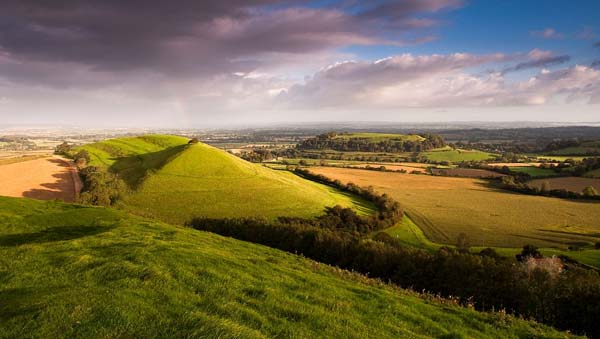
There is no concrete information to tell us where the famous Kingdom of Camelot might have been, but those who believe the kingdom is based on an actual place in Britain most often name Cadbury Castle as one of the important places of Camelot. If you ever visit it, you will have to leave the A303 highway (that runs from Basingstoke in Hampshire to Honiton in Devon, England) at Chapel Cross, approximately 1.5 miles east of Sparkford, and then follow a small road that first passes South Cadbury village and eventually comes to the foot of the only path up the isolated hill where the castle stands. It was first proposed as Camelot in the mid-16th century, by John Leland, but many other scholars disagree, citing other possible locations for King Arthur’s mighty kingdom.
A Number of Other Places Could Actually Have Been a Part of the Camelot Kingdom
In addition to Cadbury Castle, various other locations in Britain are believed to have been a part of the famous Camelot from the Arthurian legend. Some of the most famous are: Caerleon in Wales (a place which has numerous Arthurian traditions), Camelford in Cornwall, England (due to the name similarity), Killbury in Cornwall, England (believed to have been Arthur’s Court of Kelliwic), Slack in West Yorkshire, England (Roman name Camulodunum), and Winchester in Hampshire, England (Winchester Castle features a round table). There are many other towns and villages in Britain which claim some connection to the Kingdom of Camelot, and most of them know only too well how interesting the name of King Arthur is to foreign tourists…
It Is Still Not Completely Clear Where Exactly King Arthur Could Be Buried
But King Arthur facts reveal that the most likely burial place of King Arthur is Glastonbury Abbey in Glastonbury, a small town of fewer than 10,000 inhabitants in Somerset, England, approximately 20 miles south of the city of Bristol. This belief originates from the writings of a medieval historian named Gerald of Wales, who claimed that King Henry II sent a message to the abbot of Glastonbury Abbey in 1889, regarding the location of the grave of King Arthur. He had been informed that the great British ruler was resting there by an unnamed Welsh bard. Shortly after that, in 1890, the monks of Glastonbury supposedly uncovered a hollow log containing two bodies and an oddly shaped cross with a Latin inscription, identifying the two bodies as King Arthur and his queen Guinevere. But some people do not believe the monks’ story, can you imagine that?
King Arthur Facts — Facts about King Arthur Summary
 King Arthur is a mythological king who supposedly ruled Britain in the late 5th century and early 6th century. There has been a centuries-long debate regarding whether King Arthur was a real person, a myth coined by combining various heroes (real or imaginary) of the time, or just a clever fictitious creation of various medieval writers. King Arthur’s legend was spread throughout Europe through Geoffrey of Monmouth’s Historia regum Britanniae in the 12th century, although various other (earlier and later) legends exist. The Arthurian legend is full of interesting locations, items and people, such as the powerful Merlin the Enchanter, the beautiful Queen Guinevere, the traitorous knight Lancelot, the mighty sword Excalibur, the mysterious Lady of the Lake, the evil sorceress Morgan le Fay, the mighty kingdom of Camelot, the mysterious island of Avalon and many others…
King Arthur is a mythological king who supposedly ruled Britain in the late 5th century and early 6th century. There has been a centuries-long debate regarding whether King Arthur was a real person, a myth coined by combining various heroes (real or imaginary) of the time, or just a clever fictitious creation of various medieval writers. King Arthur’s legend was spread throughout Europe through Geoffrey of Monmouth’s Historia regum Britanniae in the 12th century, although various other (earlier and later) legends exist. The Arthurian legend is full of interesting locations, items and people, such as the powerful Merlin the Enchanter, the beautiful Queen Guinevere, the traitorous knight Lancelot, the mighty sword Excalibur, the mysterious Lady of the Lake, the evil sorceress Morgan le Fay, the mighty kingdom of Camelot, the mysterious island of Avalon and many others…
Was this page helpful?
Our commitment to delivering trustworthy and engaging content is at the heart of what we do. Each fact on our site is contributed by real users like you, bringing a wealth of diverse insights and information. To ensure the highest standards of accuracy and reliability, our dedicated editors meticulously review each submission. This process guarantees that the facts we share are not only fascinating but also credible. Trust in our commitment to quality and authenticity as you explore and learn with us.


